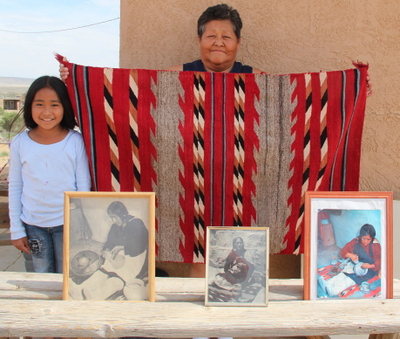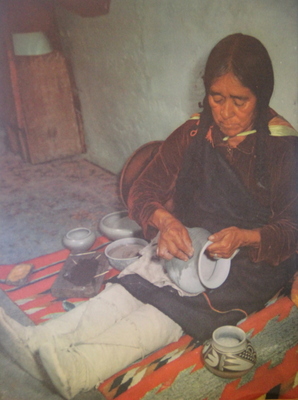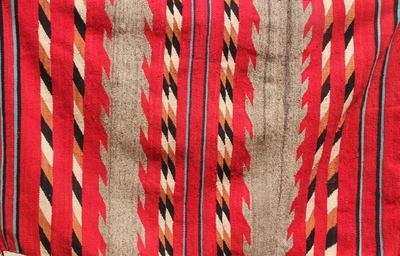Carletta Hayah’s Talking Blanket

Carletta Hayah and her granddaughter show the “talking” blanket that belonged to Carletta’s grandmother.
“Wow, do I ever wish this weaving could talk!” When I’m analyzing a rug, there are so many times that I’ve said that to myself or to whoever was in earshot. Well, in May I found one that could talk. OK, it might be more appropriate to say that it had a good interpreter. It all started when I got a call from Carletta Hayah, who lives in Polacca on the Hopi Reservation. Carletta was looking for an appraisal value for a blanket that had been in her family for a long time. Several people had tried to buy it from her, she told me, but she had no idea what it was worth. “It was in Arizona Highways”, she said. Well, that’s interesting, I thought, and I had business that was going to take me near her home, so I went to Polacca and despite my relatively poor understanding of the milepost system, I managed to find Carletta’s home. And there was the talking blanket.
Meet The Talking Blanket
That’s Carletta holding the blanket in the picture above and here’s the story that she tells about it. The blanket has been in her family since before she was born. Carletta’s grandfather was a farmer, a really good and prosperous one. “He grew all kinds of fruits and vegetables”, Carletta said. “Not like today where they truck everything in. He grew apricots, peaches, apples, corn, squash, all kinds of things. He had sheep too, and he traded with people all over the area. He usually went to Keams Canyon to trade with the Navajos. I think that’s how he got the blanket”.
Carletta’s grandmother was also a hard working woman with a reputation for making excellent pottery. Her name was Kate Nuvi Seena. In the 1950’s, a man with a huge camera came to the Seena’s home in Walpi and asked if could take pictures of Kate working on her pottery. The Seena’s agreed and the man took quite a few pictures of Kate at work, seated on the blanket that her husband had traded for . Carletta was a little girl and still remembers how funny this man looked with his head covered with cloth as he operated the camera. The photographer sent the Seenas some of the prints that he made and told the them that they might appear in the Arizona Highways magazine. As far as Carletta knows, they were the only pictures that anyone ever took of Kate.
What Carletta Really Wanted
Eventually, one of Kate’s sons found one of the Arizona Highways pictures in a copy of the magazine and he cut it out and framed it. The Seenas framed the prints that the photographer sent but after so many years they were deteriorating. It was pretty obvious that Carletta wanted better pictures at least as much as she wanted to know about the blanket. Over the years, people had promised to contact Arizona Highways and see about prints, but nothing had ever come of it. Arizona Highways is in Phoenix and it’s a long way from Polacca in more ways than one. So I took pictures of her pictures and pictures of the blanket and pictures of her granddaughter, who really wanted to have her picture taken. And I went home to Phoenix.
Enter Arizona Highways
The next week, I sent a note to Arizona Highways along with my pictures of the pictures and the Reader’s Digest version of Carletta’s story and the possibility that maybe the picture appeared in April of 1952. Did they have negatives? Could we get reprints?
I figured that I was in for a long wait if I got any answer at all, so I was really surprised the next morning with a response from one of the editors. No, she told me, the magazine did not keep negatives, and they couldn’t find the picture that Carletta had. They had found another one. That yielded the name J.H. McGibbeny, a prolific photographer whose work spans much of the mid 20th century. The Native American people of southern Utah and northern Arizona were among his favorite subjects and his work frequently appeared in Arizona Highways. They still had copies of most of the issues from the 1950’s. If I went over there, I was welcome to look through them. I never did find the issue that had the picture Carletta’s uncle had cut out of the magazine, but on the back cover of the August 1958 issue, there is a magnificent color picture of Kate Nuvi Seena seated on her blanket making pottery. I made prints of all the pictures that I had taken, which turned out pretty well and delivered them to Carletta along with the information about Mr. McGibbeny and the 1958 issue of the magazine.
Validation is the Best Reward
When Carletta got those prints and the information about Mr. McGibbeny and the magazine, it validated her instinct to save that blanket from being tossed out when other family members didn’t want it anymore. It validated all the years that she had resisted selling it to the people her offered $50 to take it off her hands. No, it’s not a million dollar second phase Chief Blanket; but it’s a late 1930’s double saddle blanket made with a combination of hand spun wool with some leftover Germantown here and there. Her grandfather traded with one of his Navajo neighbors to get it about 75 years ago. Her grandmother sat on it over 60 years ago so that a man with a hilarious camera could take her picture and Arizona Highways could publish it. And as long as anyone can see this article, it can talk.
| |
Hagoshíí (so long for now)
Mary Walker


